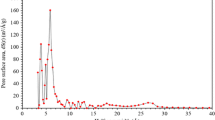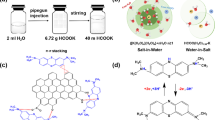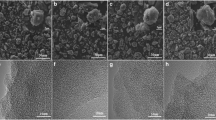Abstract
Electric double-layer capacitors (EDLCs) are composed of two activated carbon (AC) electrodes and an electrolyte/separator, in which the ACs contain numbers of surface oxygen functionalities (SOFs). In this work, the effect of SOFs on the EDLC’s capacitance in non-aqueous electrolytes is studied by using a 1.0 m (molality) LiPF6 3:7 (wt.) ethylene carbonate-ethyl methyl carbonate electrolyte and a commercial activated carbon. Results show that the SOFs on one hand contribute to Faradic pseudocapacitance, and on the other hand adversely reduce the EDLC’s performances, including the initial reversibility, coulombic efficiency, and capacitance retention. It is found that the AC behaves significantly different in the Li/AC half cells and in the AC/AC full cells and that the SOF’s pseudocapacitance increases with widening the EDLC’s operating voltage. The latter is attributed to the large-voltage hysteresis of the redox of SOFs. In this paper, the AC’s unique behaviors in Li salt electrolyte are presented, and a possible mechanism for the observed behaviors is proposed.







Similar content being viewed by others
References
Kotz R, Carlen M (2000) Principles and applications of electrochemical capacitors. Electrochim Acta 45:2483–2498
Frackowiak E, Beguin F (2001) Carbon materials for the electrochemical storage of energy in capacitors. Carbon 39:937–950
Miller JR (2016) Engineering electrochemical capacitor applications. J Power Sources 326:726–735
Pandolfo AG, Hollenkamp AF (2006) Carbon properties and their role in supercapacitors. J Power Sources 157:11–27
Wei L, Yushin G (2012) Nanostructured activated carbons from natural precursors for electrical double layer capacitors. Nano Energy 1:552–565
Revo SL, Budzulyak IM, Rachiy BI, Kuzishin MM (2013) Electrode material for supercapacitors based on nanostructured carbon. Surf Eng Appl Elect 49:68–72
Hung K, Masarapu C, Ko T, Wei B (2009) Wide-temperature range operation supercapacitors from nanostructured activated carbon fabric. J Power Sources 193:944–949
Zhang Q, Rong J, Ma D, Wei B (2011) The governing self-discharge processes in activated carbon fabric-based supercapacitors with different organic electrolytes. Energy Environ Sci 4:2152–2159
Beguin F, Presser V, Balducci A, Frackowiak E (2014) Carbons and electrolytes for advanced supercapacitors. Adv Mater 26:2219–2251
Zhang X, Kühnel RS, Passerini S, Balducci A (2015) “Double-salt” electrolytes for high voltage electrochemical double-layer capacitors. J Sol Chem 44:528–537
Van Aken KL, Beidaghi M, Gogotsi Y (2015) Formulation of ionic-liquid electrolyte to expand the voltage window of supercapacitors. Angew Chem Int Ed 54:4806–4809
Rodriguez-Reinoso F (1998) The role of carbon materials in heterogeneous catalysis. Carbon 36:159–175
Romero-Anaya AJ, Lillo-Roenas MA, Linares-Solano A (2015) Factors governing the adsorption of ethanol on spherical activated carbons. Carbon 83:240–249
Marsh H, Rodriguez-Reinoso F (eds) (2006) Activated carbon. Elsevier, Amsterdam Chapters 5 and 6
Pendleton P, Wu SH, Badalyan A (2002) Activated carbon oxygen content influence on water and surfactant adsorption. J Colloid Interf Sci 246:235–240
Babel K, Jurewicz K (2004) KOH activated carbon fabrics as supercapacitor material. J Phys Chem Solids 65:275–280
Alam S, Seema BFK (2009) Elemental analysis of activated carbon by EDS spectrophotometry and X-rays diffraction. J Chem Soc Pakistan 31:46–58
Figueiredo JL, Pereira MFR, Freitas MMA, Orfao JJM (1999) Modification of the surface chemistry of activated carbons. Carbon 37:1379–1389
Lennon D, Lundie DT, Jackson SD, Kelly GJ, Parker SF (2002) Characterization of activated carbon using X-ray photoelectron spectroscopy and inelastic neutron scattering spectroscopy. Langmuir 18:4667–4673
Nakamura M, Nakanishi M, Yamamoto K (1996) Influence of physical properties of activated carbons on characteristics of electric double-layer capacitors. J Power Sources 60:225–231
Kim CH, Pyun SI, Shin HC (2002) Kinetics of double-layer charging/discharging of activated carbon electrodes—role of surface acidic functional groups. J Electrochem Soc 149:A93–A98
Hsieh CT, Teng H (2002) Influence of oxygen treatment on electric double-layer capacitance of activated carbon fabrics. Carbon 40:667–674
Qu DY (2002) Studies of the activated carbons used in double-layer supercapacitors. J Power Sources 109:403–411
Okajima K, Ohta K, Sudoh M (2005) Capacitance behavior of activated carbon fibers with oxygen-plasma treatment. Electrochim Acta 50:2227–2231
Seredych M, Hulicova-Jurcakova D, Lu GQ, Bandosz TJ (2008) Surface functional groups of carbons and the effects of their chemical character, density and accessibility to ions on electrochemical performance. Carbon 46:1475–1488
Oh YJ, Yoo JJ, Kim YI, Yoon JK, Yoon HN, Kim JH (2014) Oxygen functional groups and electrochemical capacitive behavior of incompletely reduced graphene oxides as a thin-film electrode of supercapacitor. Electrochim Acta 116:118–128
Hatzell MC, Raju M, Watson VJ, Stack AG, van Duin ACT, Logan BE (2014) Effect of strong acid functional groups on electrode rise potential in capacitive mixing by double layer expansion. Environ Sci Technol 48:14041–14048
Moussa G, Matei Ghimbeu C, Taberna PL, Simon P, Vix-Guterl C (2016) Relationship between the carbon nano-onions (CNOs) surface chemistry/defects and their capacitance in aqueous and organic electrolytes. Carbon 105:628–637
Azais P, Duclaux L, Florian P, Massiot D, Lillo-Rodenas MA, Linares-Solano A (2007) Causes of supercapacitors ageing in organic electrolyte. J Power Sources 171:1046–1053
Ishimoto S, Asakawa Y, Shinya M, Naoi K (2009) Degradation responses of activated-carbon-based EDLCs for higher voltage operation and their factors. J Electrochem Soc 156:A563–A571
Pohlmann S, Lobato B, Centeno TA, Balducci A (2013) The influence of pore size and surface area of activated carbons on the performance of ionic liquid based supercapacitors. Phys Chem Chem Phys 15:17287–17294
Zhang SS, Xu K, Jow TR (2006) Study of the charging process of a LiCoO2-based Li-ion battery. J Power Sources 160:1349–1354
Li Z, Xu Z, Wang H, Ding J, Zahiri B, Holt CMB (2014) Colossal pseudocapacitance in a high functionality-high surface area carbon anode doubles the energy of an asymmetric supercapacitor. Energy Environ Sci 7:1708–1718
Liu C, Koyyalamudi BB, Li L, Emani S, Wang C, Shaw LL (2016) Improved capacitive energy storage via surface functionalization of activated carbon as cathodes for lithium ion capacitors. Carbon 109:163–172
Xu K, Ding SP, Jow TR (1999) Toward reliable values of electrochemical stability limits for electrolytes. J Electrochem Soc 146:4172–4178
Zhang SS (2017) Eliminating pre-lithiation step for making high energy density hybrid Li-ion capacitor. J Power Sources 343:322–328
Largeot C, Portet C, Chmiola J, Taberna PL, Gogotsi Y, Simon P (2008) Relation between the ion size and pore size for an electric double-layer capacitor. J Amer Chem Soc 130:2730–2731
Jackel N, Rodner M, Schreiber A, Jeongwook J, Zeiger M, Aslan M (2016) Anomalous or regular capacitance? The influence of pore size dispersity on double-layer formation. J Power Sources 326:660–671
Laoire CO, Mukerjee S, Abraham KM, Plichta EJ, Hendrickson MA (2010) Influence of nonaqueous solvents on the electrochemistry of oxygen in the rechargeable lithium−air battery. J Phys Chem C 114:9178–9186
Acknowledgments
The author is grateful to Drs. J. Read and C. Lundgren for their critical reading of the manuscript and valuable comments.
Author information
Authors and Affiliations
Corresponding author
Electronic supplementary material
ESM 1
(DOCX 447 kb)
Rights and permissions
About this article
Cite this article
Zhang, S.S. Effect of surface oxygen functionalities on capacitance of activated carbon in non-aqueous electrolyte. J Solid State Electrochem 21, 2029–2036 (2017). https://doi.org/10.1007/s10008-017-3576-5
Received:
Revised:
Accepted:
Published:
Issue Date:
DOI: https://doi.org/10.1007/s10008-017-3576-5




